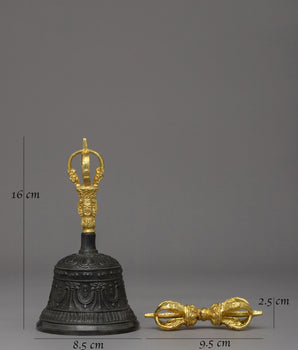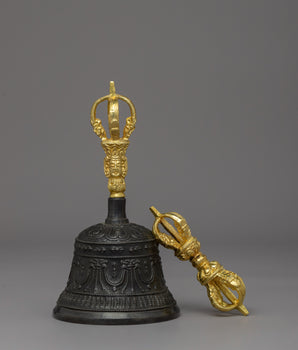A Journey Through the Mandala of Consciousness and the Transformation of the Five Poisons
Buddhist iconography employs symbols to convey spiritual truths and foster a meditative mindset. The 5 Jewel Crown of the Buddha is a sacred, mystical, and striking image of spiritual sovereignty and awakened or enlightened consciousness. With five jewels, one of each element, the jewels emit luminance with distinct energies and colors. The crown signifies the pinnacle of the enlightened mind free of ego, delusion, and suffering. These metaphysical jewels represent wisdom and purity and demonstrate our ability to transform ordinary, material perception into divine consciousness. For dedicated practitioners, the crown is a reminder of their potential. It symbolizes the process of transforming ignorance into wisdom, anger into clarity, pride into humility, and desire into compassion. It can be used in meditation and serves as a mirror, reflecting our original Buddha nature and ultimate truth.
What Is the 5 Jewel Crown?

The Five-Jewel Crown is a sacred and symbolic headdress in Mahayana and Vajrayana Buddhist art, worn by celestial Buddhas and high Bodhisattvas, such as Vairocana and Avalokiteshvara. It symbolizes spiritual kingship, mastery that derives from inner awakening, wisdom, and transcendence of self. The crown embodies dominion over self by taming the mind, dissolving delusion, and raising insight. Each of the five radiant jewels of the crown possesses profound esoteric significance and, thereby, embodies the energies that are transformed from the five root mental afflictions of ignorance, anger, pride, desire, and envy when purified.
The crown corresponds to the Five Dhyani (Wisdom) Buddhas, where each of the Buddhas represents a unique aspect of the enlightened mind or state, as well as the direction in the mandala. Ultimately, as a visual representation of the five Buddha families, the crown symbolizes the complete spectrum of our possibilities for awakening, as each of the five Buddha families is associated with a specific color, element, mudra, and spiritual qualities.
Pancha Buddha (Five Dhyani-Buddha)
The Pancha Buddhas are Mahayana and Vajrayana Buddhist celestial Buddhas that represent the five primary aspects of enlightened consciousness. Every Buddha represents a certain wisdom that can rescue a particular human delusion or "poison" and turn it into spiritual knowledge. Vairocana is the middle point and is associated with the all-encompassing wisdom; Akshobhya in the east is associated with the wisdom of mirror-like reality; Ratnasambhava in the south shows the wisdom of the equanimity; Amitabha in the west is the discriminating awareness; and Amoghasiddhi in the north is the wisdom of the fearless, skillful actions. The combination of all of them creates the spiritual structure of the Five Jewel Crown and the mandala of the awakened mind.
The Five Jewel Crown: Transformation of the Five Poisons

The Five Poisons of Buddhist teaching and philosophy, and the Tibetan Buddhist, Vajrayana tradition specifically, are the five emotional afflictions obscuring the mind's true nature. These are: ignorance (delusion), anger (aversion), pride (ego), desire (attachment), and jealousy (envy). They are called poisons because they contaminate perception, causing suffering or samsara, and perpetuating the cycle of suffering.
The five mental afflictions are not inherently "bad." Instead, they are raw energies that can be interpreted as poisons. When contemplating and working skillfully, they can become the Five Wisdoms, which are enlightened qualities indicating the mind's purified nature.
|
Mental Affliction |
Transformed Into |
Jewel Color |
Associated Buddha |
Direction |
|
Ignorance |
Wisdom of the dharma realm |
White |
Vairocana |
Center |
|
Anger |
Mirror-Like Wisdom |
Blue |
Akshobhya |
East |
|
Pride |
Wisdom of Equality |
Yellow |
Ratnasambhava |
South |
|
Attachment |
Discriminating Awareness Wisdom |
Red |
Amitabha |
West |
|
Jealousy |
All- Accomplishing Wisdom |
Green |
Amoghasiddhi |
North |
The Five Jewels and Their Deeper Meaning

The Five Jewels in the Buddha's crown are not simply pieces of jewelry; they are portals to powerful spiritual insight, and they symbolize the journey from an ordinary mind to awakening. Each jewel is associated with a color, a type of wisdom, a Buddha family, and a direction in the sacred mandala. Together, they create a whole path to liberation for students to transform negative emotion into awakened awareness.
1. White Jewel – Akshobhya Buddha
The white jewel rests as a message of clarity, purity, and complete reflection. Like a still, unclouded mirror, mirror-like wisdom reflects all phenomena as is, with no distortion, attachment, or bias. It shows us the naked reality of every phenomenon, apart from the ego and emotional interference.
This jewel is the transmutation of anger and aversion into calm clarity. It is related to the Buddha Akshobhya, the unshakeable Buddha, who is associated with mental steadiness, non-reactivity, and clarity. His wisdom teaches us the quality of seeing beyond illusion, no matter what happens around us, and how to stay calm and steady inside without being swayed by inner or outer turbulence.
2. Blue Jewel - Ratnasambhava Buddha
Although frequently represented as golden or yellow in the sūtras, this blue jewel in this crown context symbolizes the steady, calming, and balancing quality of equanimity. Equanimity is the capacity to hold all things, pain or pleasure, gains or losses, with the same spacious awareness; establishing a steady self-stabilizing agency within.
This jewel turns pride and superiority into a deep-seated sense of equality, humility, and generosity, reminding us that the same potential for being is present in all beings. It corresponds to Ratnasambhava, the Buddha of abundance, generosity, and inner richness. He invites us to explore the extent to which we can inhabit empathy and dignity towards one another and every precious life.
3. Yellow Jewel - Amoghasiddhi Buddha
The yellow jewel shines with the active quality of discernment, by empowering the practitioner to discern the ways of truth from falsehood, skillful means from harm, and ethical choices that promote kindness, compassion, and awareness.
This jewel transforms envy and jealousy into a capacity for celebrating the good fortune of others and taking action with right intention. It is associated with Amoghasiddhi, the Buddha of successful action and fearless determination, whose wisdom enables us to act on our most significant values and profoundest understanding.
4. Red Jewel - Amitabha Buddha
The red jewel shines with the warmth of love, compassion, and innate understanding. It returns the wisdom of discriminating awareness - the ability to know the uniqueness of each moment, each person, or each emotion, all without losing ourselves in judgment or attachment.
This jewel transforms desire and grasping into a response of unconditional compassion because we act from presence, not need. The red jewel and Discriminating Awareness Wisdom are associated with Amitabha, the Buddha of infinite light and love, who resides in the Western Pure Land. Bodhisattvas and their enlightened qualities enable us to recognize the beauty and holiness of beings, helping to nurture a deep and open heart awareness.
5. Green jewel - Vairocana Buddha
The green jewel sits at the head of the crown, representing the peak and integration of all the other wisdoms. It represents what Buddhists recognize as All-Accomplishing Wisdom, wisdom allows one to manifest the enlightened qualities of the Buddhas in efficacious action, as one moves across the world with compassion, clarity, and intentionality.
This jewel transforms ignorance and confusion into awakened knowledge and skilful action. The green jewel and All-Accomplishing Wisdom correlate to Vairocana, the central, cosmic Buddha, and the representation of Dharmakaya, or the infinite and all-encompassing nature of reality. This jewel reminds us that enlightenment is active and takes form in action. It is the wisdom that incites Bodhisattvas to work hard for the liberation of all beings.
Crown as a Mandala: A Metaphor for The Inner Journey

In esoteric Buddhist teachings, and particularly within the Vajrayana and Mahayana schools, the Five Jewel Crown is much more than just a decorative representation of enlightenment. It is a living mandala, or sacred cosmological diagram, representing the very architecture of the enlightened mind. Suppose a traditional mandala illustrates a perfected universe and the awakened consciousness present at its center. In that case, the crown worn by the Buddha also serves as a spiritual map that directs seekers inward in their process of self-realization.
Each of the five radiant jewels sits in alignment with a cardinal direction, east, south, west, north, and center, and as it does so, relates to one of the Five Dhyani Buddhas, to the Five Wisdoms, and the Five Buddha Families. These energies are not just symbolic representations but archetypal energies contained within each of us waiting to be empowered, realized, recognized, and then integrated.
Ritual Use of the Five Jewel Crown

1. Empowerment (Abhisheka) Ritual:
A crown rests upon the crown of a practitioner or deity form during tantric initiation rites to signify the empowerment of the Five Wisdoms and transference to become a member of the Buddha's mandala of enlightenment.
2. Deity Visualization Practices:
Practitioners visualize themselves engaging with a deity having the Five Jewel Crown to coil the Pancha Buddhas' lofty qualities into their mindstream.
3. Purification of the Five Poisons:
Each jewel of the crown signifies a particular mental affliction. By visualizing a remedy for each poison, the practitioner transforms poison into the Five Wisdoms.
4. Activation of the Subtle Body:
The crown invokes and harmonizes the chakras relevant to each of the Five Buddhas, which assists spiritual metamorphosis in the subtle body.
5. Expressing Spiritual Sovereignty:
Having the crown or climbing into and envisioning the crown in ritual is a proclamation of not being commanded by the ego and that you identify with the awakened mind instead of the conditioned self.
6. Mandala Entry:
The Five Jeweled Crown is the center axis or dharma realm of the mandala. In ritual, this signifies the practitioner’s individuation into the sacred geometry of thought and awareness that is enlightenment.
Conclusion
The Five Jewel Crown of the Buddha is a personal symbol, a meditation method, and a pathway to awakening that represents the full range of the inner alchemical process for the ordinary mind to transform into the Five Wisdoms. Every gem on the crown has a unique energetic quality, each representing one of the Pancha Buddhas, sacred directions, and enlightened qualities. The crown is a living mandala that embodies the union of our body, mind, and spirit with the cosmos of awakening. In ritual and personal meditation, it leads to initiation, visualization, purification, and transformation, directing us from delusion to realization. When we contemplate or visualize the crown, we first begin to awaken to see the sacred geometry of the universe and our own Buddha essence. Enlightenment is the potential we each possess that we are waiting to uncover. The jewels of awareness are meant to rest in each of us, crowning our existence with mindfulness, awakening, and limitless compassion.












